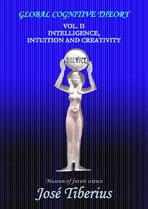1. Theory of intelligence
The second book on the Global Cognitive Theory refers to the different meanings, and it defines the elegant intelligence as an active subject of knowledge management; this is, without any pseudo-scientific refinement aiming to deny the existence of such a capacity.
Pseudo-scientific because it is evident that this capacity exists and following Galileo's scientific method or, if preferred, the Veus vei method discoursed in Global Scientific Method, it is not necessary to demonstrate what is obvious; besides, sometimes it is not even possible to do so.

The introduction of the first book on the Global Cognitive Theory, The Human Brain and Computers, discusses the general context of the books about evolution and cognitive psychology in Molwickpedia.
Also, in the section called Global Cognitive Theory of the book The Human Brain and Computers is a summary of the four books that make it up. Besides, it mentions the experimental psychology studies related to the said theory.
Chapter II, intuition and creativity, try, on the one hand, to criticize the multiple concepts associated with the word intelligence, like the concepts of Howard Gardner's multiple intelligences and Daniel Goleman’s emotional intelligence. On the other hand, it also establishes the essence of the popular idea of normal or general intelligence.
Within the different existing concepts in the theory of intelligence, the capacity for making abstract relations seems to be the most appropriate definition.
A deepening of the theory about the conditions and mechanisms lead to the definition of conditional intelligence. A significant case would be reliable answers.
These elucidations allow to approach the concepts of intelligence in a strict sense or G factor and discuss some particularities about the male and female brain. The whole cognitive manager would be elegant intelligence.
Chapter III focuses on the relevant types of operational conditions regarding the reliability and speed of the output. The context of the Global Cognitive Theory allows this innovative analysis.
Firstly, the automatic answers would be found, such as preconceptions or emotions, since, due to their nature, they must be answers of the unconscious.
In the second place, accurate functions have been included, such as logical inference or the so-called mathematical memory.
After that, with lower requirements of reliability, it comes across intuition and standard memory.
Then, an approximation to the unique case of language is carried out; emphasizing its impressive speed as lack of precision. Regarding creativity, the characteristics are its complexity and powerful relational functions.
The mentioned context of the Global Cognitive Theory relates to evolutionary psychology and, more specifically, the General Theory of Conditional Evolution of Life.
Chapter IV examines the effects of inheritance and environment within the theory of intelligence.
In the first part, there is a review of the studies on the genetic inheritance of intelligence and its interpretation in favor of the Global Cognitive Theory. It also includes two possible methods of intelligence improvement procedures using genetic engineering.
The second block of ideas discusses the philosophical or sociological motivations as opposed to the genetic influence. Some ideas sometimes even deny the very concept of intelligence.
The problems and intricacy of intelligence tests are in chapter IV. However, going to the moon was more complicated and, curiously, only some lunatics deny that humankind has been there.
Another section explains the experimental research difficulties, especially the shortage of data source. These limitations are so severe that are only understandable thanks to the social sensitivity a significant scientific rigor might entail.
Finally, chapter V exposes the traffic light metaphor as an example of multiple concepts associated with the kindness of a car, showing the possible routes, conditions and times; and simultaneously, the simplicity of quality indicators when not using the same words for different concepts.
